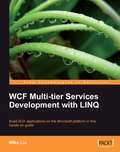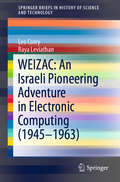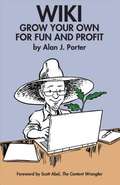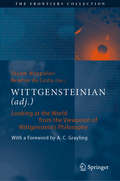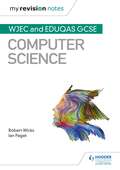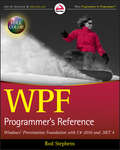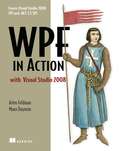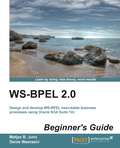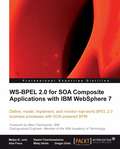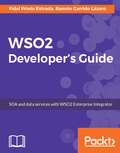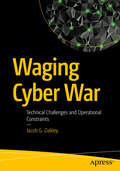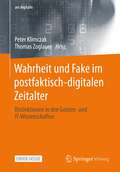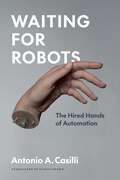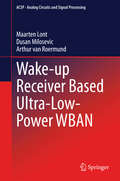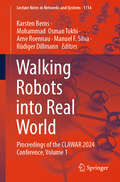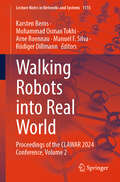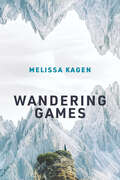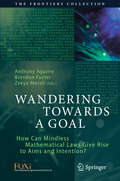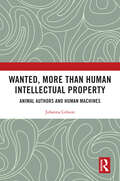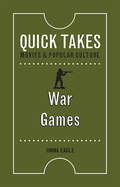- Table View
- List View
WCF Multi-tier Services Development with LINQ
by Mike LiuThis book is a step-by-step tutorial with clear instructions and screenshots to guide you through the creation of a multi-tier real-world WCF service solution. Configuration files, host applications, test clients, and WCF services for each solution will be available for download on this website for you to examine, modify, and debug from the outside to the inside.The book focuses on the essentials of using WCF and LINQ, rather than providing a reference to every single possibility. It leaves the reference material online where it belongs, and concentrates instead on practical examples, code, and advice.This book is for C# and C++ developers who are eager to get started with WCF and LINQ, and want a book that is practical and rich with examples from the very beginning. Developers and architects evaluating SOA implementation technologies for their company will find this book particularly useful because it gets you started with Microsoft's tools for SOA and shows you how to customize our examples for your prototypes.This book presumes basic knowledge of C# or C++. Previous experience with Visual Studio will be helpful but is not required, as detailed instructions are given throughout the book.
WEIZAC: An Israeli Pioneering Adventure in Electronic Computing (SpringerBriefs in History of Science and Technology)
by Leo Corry Raya LeviathanThe book tells the unique story of WEIZAC, an early computer built by a “new nation” in the early 1950s. It was created in Israel, even though the feasibility of this project was actually close to null when it was initially conceived, in 1946, and, unlike most of the early computer projects, was privately financed mainly by the Jewish world community. The book draws on a wealth of documents and historical insights to reveal the processes and powers that led to the successful completion of the project and, as well as its actual impact on scientific activities in Israel, and on the rise of a local computing community.Based on archival data, the book shows how a synergy of personal dedication together with an organizational and national mission that links the Zionist vision with science and technology for the Jewish people helped to achieve a well-defined goal.The book offers intriguing insights and refreshing perspectives to all readers interested in the Zionist movement or in the history of computing.
WHOIS Running the Internet
by Garth O. BruenDiscusses the evolution of WHOIS and how policy changes will affect WHOIS' place in IT today and in the futureThis book provides a comprehensive overview of WHOIS. The text begins with an introduction to WHOIS and an in-depth coverage of its forty-year history. Afterwards it examines how to use WHOIS and how WHOIS fits in the overall structure of the Domain Name System (DNS). Other technical topics covered include WHOIS query code and WHOIS server details. The book also discusses current policy developments and implementations, reviews critical policy documents, and explains how they will affect the future of the Internet and WHOIS. Additional resources and content updates will be provided through a supplementary website. Includes an appendix with information on current and authoritative WHOIS services around the world Provides illustrations of actual WHOIS records and screenshots of web-based WHOIS query interfaces with instructions for navigating them Explains network dependencies and processes related to WHOIS utilizing flowcharts Contains advanced coding for programmers WHOIS Running the Internet: Protocol, Policy, and Privacy is written primarily for internet developers, policy developers, industry professionals in law enforcement, digital forensic investigators, and intellectual property attorneys.Garth O. Bruen is an Internet policy and security researcher whose work has been published in the Wall Street Journal and the Washington Post. Since 2012 Garth Bruen has served as the North American At-Large Chair to the Internet Corporation of Assigned Names and Numbers (ICANN). In 2003 Bruen created KnujOn.com with his late father, Dr. Robert Bruen, to process and investigate Internet abuse complaints (SPAM) from consumers. Bruen has trained and advised law enforcement at the federal and local levels on malicious use of the Domain Name System in the way it relates to the WHOIS record system. He has presented multiple times to the High Technology Crime Investigation Association (HTCIA) as well as other cybercrime venues including the Anti-Phishing Working Group (APWG) and the National Center for Justice and the Rule of Law at The University of Mississippi School of Law. Bruen also teaches the Fisher College Criminal Justice School in Boston where he develops new approaches to digital crime.
WIKI
by Alan J. PorterWIKI: Grow Your Own for Fun and Profit introduces the concept of wikis, and shows why they are becoming the must-have communications and collaboration technology for businesses of any size. Using a garden as a metaphor, Alan J. Porter shows you step-by-step how to select wiki software, get started, overcome resistance to wikis, maintain your wiki, and use your wiki for internal collaboration, project planning, communication with your customers, and more. Includes five case studies that highlight the ways companies are using wikis to solve business and communication problems, increase efficiency, and improve customer satisfaction. Inside the Book A Brief History of Collaboration Defining the Wiki Planting the Seed First Growth Maintaining the Garden Landscaping Harvesting the Information A Wiki Checklist Notes on Popular Wiki Software Resources and Index
WITTGENSTEINIAN: Looking at the World from the Viewpoint of Wittgenstein's Philosophy (The Frontiers Collection)
by Shyam Wuppuluri Newton Da Costa“Tell me," Wittgenstein once asked a friend, "why do people always say, it was natural for man to assume that the sun went round the earth rather than that the earth was rotating?" His friend replied, "Well, obviously because it just looks as though the Sun is going round the Earth." Wittgenstein replied, "Well, what would it have looked like if it had looked as though the Earth was rotating?” What would it have looked like if we looked at all sciences from the viewpoint of Wittgenstein’s philosophy? Wittgenstein is undoubtedly one of the most influential philosophers of the twentieth century. His complex body of work has been analysed by numerous scholars, from mathematicians and physicists, to philosophers, linguists, and beyond. This volume brings together some of his central perspectives as applied to the modern sciences and studies the influence they may have on the thought processes underlying science and on the world view it engenders. The contributions stem from leading scholars in philosophy, mathematics, physics, economics, psychology and human sciences; all of them have written in an accessible style that demands little specialist knowledge, whilst clearly portraying and discussing the deep issues at hand.
WJEC and Eduqas GCSE Computer Science (My Revision Notes)
by Robert Wicks Ian PagetExam board: WJECLevel: GCSESubject: Computer ScienceFirst teaching: September 2017First exams: Summer 2019Strengthen your students' understanding and upgrade their confidence with My Revision Notes: WJEC Eduqas GCSE (9-1) Computer Science.Written by leading Computer Science experts this is the only revision guide aimed specifically at helping students prepare for the WJEC or Eduqas exam - a new title in the top-selling revision guide series, loved by students and recommended by teachers.· Let students take control of their revision - plan and focus on the areas where they need to improve their knowledge and understanding with advice and summaries from the experts.· Help them achieve their potential - exam tips on computer science terms and concepts highlighted throughout the book· Improve their exam skills - a range of exam practice questions and 'test yourself questions' with answers at the back of the book.
WPF Programmer's Reference
by Rod StephensBuild effective user interfaces with Windows Presentation FoundationWindows Presentation Foundation (WPF) is included with the Windows operating system and provides a programming model for building applications that provide a clear separation between the UI and business logic. Written by a leading expert on Microsoft graphics programming, this richly illustrated book provides an introduction to WPF development and explains fundamental WPF concepts.Packed with helpful examples, this reference progresses through a range of topics that gradually increase in their complexity. You'll quickly start building applications while you learn how to use both Expression Blend and Visual Studio to build UIs. In addition, the book addresses the needs of programmer who write the code behind the UI and shows you how operations can be performed using both XAML and C#.Topics Covered:Overview of WPFWPF in Visual StudioExpression BlendCommon PropertiesContent ControlsLayout ControlsUser Interaction ControlsTwo-Dimensional Drawing ControlsPropertiesPens and BrushesEvents and Code-BehindResourcesStyles and Property TriggersEvent Triggers and AnimationTemplatesThemes and SkinsPrintingData BindingCommandingTransformations and EffectsDocumentsNavigation-Based ApplicationsThree-Dimensional DrawingSilverlightEven if you only have a minimal amount of experience, by the end of the book, you will be able to build dynamic and responsive user interfaces with WPF.Note: CD-ROM/DVD and other supplementary materials are not included as part of eBook file.
WPF in Action with Visual Studio 2008: Covers Visual Studio 2008 Service Pack 1 and .NET 3.5 Service Pack 1!
by Arlen Feldman Maxx DaymonNow more than ever, Windows applications have to work well and look good. Windows Presentation Foundation (WPF), Microsoft's new user interface framework, gives you the ability to create stunning graphics, rich interactions, and highly-usable Windows applications. WPF is the API beneath Windows Vista interfaces, and it's also available for older versions of Windows. Up to this point, it has only been possible to build WPF applications manually, mainly by hand-coding in XAML-WPF's declarative XML-based markup language. The soon-to-be-released Visual Studio 2008 provides the full set of developer tools you need to take advantage of this exciting technology.The combination of WPF and Visual Studio 2008 represents the start of the next generation of Windows applications. Hand-coding XAML is fine if you're an early adopter, but to put WPF into production, you need to master the tools and application styles you'll use in your day job.WPF In Action focuses on WPF development using Visual Studio 2008 and other available tools.. The book starts with thorough coverage of the basics-layouts, styles, resources, and themes. It then takes you through several real-world scenarios, exploring common challenges and application-types. You'll build several sample applications, ranging from a simple calculator to a typical line-of-business application. Along the way, you'll add graphical elements, animation, and support for printing, accessibility, and other standard functionality.Written in a witty, engaging style, WPF In Action can be read cover-to-cover or used to reference specific problems and issues. The approach is practical and always focused on how you'll use WPF in real development scenarios. You'll learn how to handle the many new issues presented by the extreme flexibility of WPF. The authors also provide numerous tips and suggestions for how to work efficiently. Purchase of the print book comes with an offer of a free PDF, ePub, and Kindle eBook from Manning. Also available is all code from the book.
WS-BPEL 2.0 Beginner's Guide
by Matjaz B. Juric Denis WeerasiriIf you are a software architect, a designer, a software developer, an SOA and BPM architect, a project manager, or a business process analyst who is responsible for the design and development of business processes, composite applications, and BPM/SOA solutions, then this book is for you. You should have a clear grasp of general SOA concepts including business processes and web services, but no prior knowledge of the BPEL language is required.
WS-BPEL 2.0 for SOA Composite Applications with IBM WebSphere 7
by Matjaz B. Juric Swami ChandrasekaranThis book is a comprehensive guide that shows developers how to design and develop business processes in BPEL efficiently. Throughout the book the authors discuss important concepts and offer real-world examples covering the IBM WebSphere SOA platform.This book is aimed at SOA architects and developers involved in the design, implementation, and integration of composite applications and end-to-end business processes. It provides comprehensive coverage of WS-BPEL 2.0 for implementing business processes and developing SCA composite applications, dealing with the issues of composition, orchestration, transactions, coordination, and security. It uses IBM WebSphere SOA platform version 7.0. To follow this book you need to have basic knowledge of XML, web services, and Java EE. You should also be familiar with basic concepts of Business Process Management (BPM).
WS-BPEL 2.0 for SOA Composite Applications with Oracle SOA Suite 11g
by Matjaz B. JuricThis book is a comprehensive guide that shows developers how to design and develop business processes in BPEL efficiently. Throughout the book, the authors discuss important concepts and show real-world examples covering Oracle SOA Suite 11g and related products. This book is aimed at SOA architects and developers involved in the design, implementation, and integration of composite applications and end-to-end business processes. The book provides comprehensive coverage of WS-BPEL 2.0 for implementing business processes and developing SCA composite application, dealing with the issues of composition, orchestration, transactions, coordination, and security. This book uses Oracle SOA Suite 11g and related Oracle products. To follow this book you need to have basic knowledge of XML, web services, and Java EE.
WSO2 Developer's Guide
by Fidel Prieto Estrada Ramon Garrido LazaroWSO2 Made Simple – dive deep into the core concepts of WSO2 to overcome the challenges faced while using the Enterprise Integrator About This Book • Design, create, and publish services in the WSO2 technology • Integrate the WSO2 Enterprise Integrator with other components and servers • Log and test deployed services Who This Book Is For If you are a Java solutions architect or developer and are keen to understand how to build enterprise applications with WSO2, this book is for you. No prior knowledge of WSO2 is expected. What You Will Learn • Configure WSO2 Enterprise Integrator server in a production environment • Create SOAP Proxies and REST APIs • Interact with WSO2 Message Broker • Write services using the new language: Ballerina • Schedule automatic tasks for the services you create • Manage log messages depending on the log level of the system • Integrate with social networks such as Twitter, Facebook, Instagram, and Yammer • Test SOAP Services using the Tryit feature and SoapUI tool • Work with Quality of Services In Detail WSO2 Enterprise Integrator brings together the most powerful servers provided by the WSO2 company for your SOA infrastructure. As an Enterprise Service Bus (ESB), WSO2 Enterprise Integrator provides greater flexibility and agility to meet growing enterprise demands, whereas, as a Data Services Server (DSS), it provides an easy-to-use platform for integrating data stores, creating composite views across different data sources, and hosting data services. Using real-world scenarios, this book helps you build a solid foundation in developing enterprise applications with powerful data integration capabilities using the WSO2 servers. The book gets you started by brushing up your knowledge about SOA architecture and how it can be implemented through WSO2. It will help build your expertise with the core concepts of ESB such as building proxies, sequences, endpoints, and how to work with these in WSO2. Going further, you will also get well-acquainted with DSS data service concepts such as configuring data services, tasks, events, testing, and much more. The book will also cover API management techniques. Along with ESB and DSS, you will also learn about business process servers, the rules server and other components that together provide the control and robustness your enterprise applications will need. With practical use cases, the book covers typical daily scenarios you will come across while using these servers to give you hands-on experience. Style and approach The book is a complete guide and helps you get the right start—from understanding SOA architectures to getting valuable experience with two important integration servers such as ESB and DSS. It will include some real-world practical scenarios to help you master the best practices followed right across the industry and overcome the challenges you're likely to face on a daily basis.
Wachstum durch den Einsatz von Generativer KI: Funktionsweise und Anwendungsgebiete im Marketing (essentials)
by Bernhard WeckeDieses Buch bietet einen fundierten Einblick in die Relevanz von Generativer Künstlicher Intelligenz (KI) im Marketing. Neben einer kompakten Darstellung der Funktionsweise und Grenzen von Generativer KI wird ein umfassender Überblick über KI-basierte Medienformate gegeben.Anhand von Praxisbeispielen und konkreten Auswahlkriterien erfahren Sie, wie Sie geeignete Anwendungsfälle für Generative KI identifizieren und in Ihre Marketingstrategie integrieren können. .
Waging Cyber War: Technical Challenges and Operational Constraints
by Jacob G. OakleyUnderstand the challenges of implementing a cyber warfare strategy and conducting cyber warfare. This book addresses the knowledge gaps and misconceptions of what it takes to wage cyber warfare from the technical standpoint of those with their hands on the keyboard. You will quickly appreciate the difficulty and complexity of executing warfare within the cyber domain. Included is a detailed illustration of cyber warfare against the backdrop of national and international policy, laws, and conventions relating to war.Waging Cyber War details technical resources and activities required by the cyber war fighter. Even non-technical readers will gain an understanding of how the obstacles encountered are not easily mitigated and the irreplaceable nature of many cyber resources. You will walk away more informed on how war is conducted from a cyber perspective, and perhaps why it shouldn’t be waged. And you will come to know how cyber warfare has been covered unrealistically, technically misrepresented, and misunderstood by many. What You’ll Learn Understand the concept of warfare and how cyber fits into the war-fighting domainBe aware of what constitutes and is involved in defining war and warfare as well as how cyber fits in that paradigm and vice versaDiscover how the policies being put in place to plan and conduct cyber warfare reflect a lack of understanding regarding the technical means and resources necessary to perform such actionsKnow what it means to do cyber exploitation, attack, and intelligence gathering; when one is preferred over the other; and their specific values and impacts on each otherBe familiar with the need for, and challenges of, enemy attributionRealize how to develop and scope a target in cyber warfareGrasp the concept of self-attribution: what it is, the need to avoid it, and its impactSee what goes into establishing the access from which you will conduct cyber warfare against an identified targetAppreciate how association affects cyber warfareRecognize the need for resource resilience, control, and ownershipWalk through the misconceptions and an illustrative analogy of why cyber warfare doesn't always work as it is prescribed Who This Book Is For Anyone curious about warfare in the era of cyber everything, those involved in cyber operations and cyber warfare, and security practitioners and policy or decision makers. The book is also for anyone with a cell phone, smart fridge, or other computing device as you are a part of the attack surface.
Wahrheit und Fake im postfaktisch-digitalen Zeitalter: Distinktionen in den Geistes- und IT-Wissenschaften (ars digitalis)
by Peter Klimczak Thomas ZoglauerDie Zunahme von Fake News, die stärker werdende Beeinflussung von Wahlen, zunehmende Falschmeldungen und gezielte Desinformationskampagnen sind nicht zuletzt eine Folge der fortschreitenden Digitalisierung. Um diesen Fehlentwicklungen Einhalt zu gebieten, ist die Informationstechnik gefragt. Mit intelligenten Algorithmen und einer verfeinerten Datenanalyse müssen zukünftig Fakes schneller erkannt und deren Verbreitung verhindert werden. Um jedoch Fakes mittels künstlicher Intelligenz sinnvoll zu erkennen und zu filtern, muss es möglich sein, Fakes von Fakten, Fakten von Fiktionen und Fiktionen von Fakes zu unterscheiden.In diesem Buch werden daher auch Fragen nach den Distinktionen von Fake, Faktizität und Fiktionalität gestellt. Es wird auf die dahinter liegenden Wahrheitstheorien eingegangen und es werden praktisch-technische Möglichkeiten aufgezeigt, um Wahrheit von Falschheit zu differenzieren. Mit der Berücksichtigung des Fiktionalen sowie der Annahme, dass informationstechnische Weiterentwicklung von geisteswissenschaftlichen Erkenntnissen profitieren kann, hoffen die Autorinnen und Autoren, dass inhaltliche, technische und methodische Herausforderungen der Gegenwart und Zukunft bewältigt werden können.
Waiting for Robots: The Hired Hands of Automation (The France Chicago Collection)
by Antonio A. CasilliAn essential investigation that pulls back the curtain on automation, like AI, to show human workers’ hidden labor. Artificial Intelligence fuels both enthusiasm and panic. Technologists are inclined to give their creations leeway, pretend they’re animated beings, and consider them efficient. As users, we may complain when these technologies don’t obey, or worry about their influence on our choices and our livelihoods. And yet, we also yearn for their convenience, see ourselves reflected in them, and treat them as something entirely new. But when we overestimate the automation of these tools, award-winning author Antonio A. Casilli argues, we fail to recognize how our fellow humans are essential to their efficiency. The danger is not that robots will take our jobs, but that humans will have to do theirs. In this bracing and powerful book, Casilli uses up-to-the-minute research to show how today’s technologies, including AI, continue to exploit human labor—even ours. He connects the diverse activities of today’s tech laborers: platform workers, like Uber drivers and Airbnb hosts; “micro workers,” including those performing atomized tasks like data entry on Amazon Mechanical Turk; and the rest of us, as we evaluate text or images to show we’re not robots, react to Facebook posts, or approve or improve the output of generative AI. As Casilli shows us, algorithms, search engines, and voice assistants wouldn’t function without unpaid or underpaid human contributions. Further, he warns that if we fail to recognize this human work, we risk a dark future for all human labor. Waiting for Robots urges us to move beyond the simplistic notion that machines are intelligent and autonomous. As the proverbial Godot, robots are the bearers of a messianic promise that is always postponed. Instead of bringing prosperity for all, they discipline the workforce, so we don’t dream of a world without drudgery and exploitation. Casilli’s eye-opening book makes clear that most “automation” requires human labor—and likely always will—shedding new light on today’s consequences and tomorrow’s threats of failing to recognize and compensate the “click workers” of today.
Wake-up Receiver Based Ultra-Low-Power WBAN
by Arthur Van Roermund Maarten Lont Dusan MilosevicThis book presents the cross-layer design and optimization of wake-up receivers for wireless body area networks (WBAN), with an emphasis on low-power circuit design. This includes the analysis of medium access control (MAC) protocols, mixer-first receiver design, and implications of receiver impairments on wideband frequency-shift-keying (FSK) receivers. Readers will learn how the overall power consumption is reduced by exploiting the characteristics of body area networks. Theoretical models presented are validated with two different receiver implementations, in 90nm and 40nm CMOS technology.
Walking Bassics: The Fundamentals Of Jazz Bass Playing
by Sher Music Ed FuquaThis book gives you all the basic principles underlying solid walking bass lines. Comprehensive, easy to understand, with page after page of great transcriptions of the author's walking lines on the accompanying CD. The CD of NY professional jazz players can also be used as a swinging play-along CD. Endorsed by Eddie Gomez, Jimmy Haslip, John Goldsby, etc.
Walking Robots into Real World: Proceedings of the CLAWAR 2024 Conference, Volume 1 (Lecture Notes in Networks and Systems #1114)
by Manuel F. Silva Karsten Berns Mohammad Osman Tokhi Rüdiger Dillmann Arne RoennauThe book is also a good source for courses in robotics and automation, control engineering, mechanical engineering, and mechatronics. CLAWAR 2024 is the 27th International Conference Series on Climbing and Walking Robots and Mobile Machine Support Technologies. The conference is organized by CLAWAR Association in collaboration with the RPTU Kaiserslautern-Landau and FZI Center for Information Technology, Germany, during September 4–6, 2024. CLAWAR 2024 provides the latest research and development findings and state-of-the-art insights into the mobile robotics and associated technologies in a diverse range of application scenarios, within the framework of “walking robots into real world.” The topics covered include AI-based systems and solutions, biologically inspired systems and solutions, human-like robots, innovative grippers, innovative robot design, planetary exploration, planning and control, prosthetics and rehabilitation, quadruped robots, and robotic applications. The intended readership includes participants of CLAWAR 2024 conference, worldwide researchers, scientists, and educators in the areas of robotics and related topics.
Walking Robots into Real World: Proceedings of the CLAWAR 2024 Conference, Volume 2 (Lecture Notes in Networks and Systems #1115)
by Manuel F. Silva Karsten Berns Mohammad Osman Tokhi Rüdiger Dillmann Arne RoennauThe book is also a good source for courses in robotics and automation, control engineering, mechanical engineering, and mechatronics. CLAWAR 2024 is the 27th International Conference Series on Climbing and Walking Robots and Mobile Machine Support Technologies. The conference is organized by CLAWAR Association in collaboration with the RPTU Kaiserslautern-Landau and FZI Center for Information Technology, Germany, during September 4–6, 2024. CLAWAR 2024 provides the latest research and development findings and state-of-the-art insights into the mobile robotics and associated technologies in a diverse range of application scenarios, within the framework of “walking robots into real world.” The topics covered include AI-based systems and solutions, biologically inspired systems and solutions, human-like robots, innovative grippers, innovative robot design, planetary exploration, planning and control, prosthetics and rehabilitation, quadruped robots, and robotic applications. The intended readership includes participants of CLAWAR 2024 conference, worldwide researchers, scientists, and educators in the areas of robotics and related topics.
Walling Out the Insiders: Controlling Access to Improve Organizational Security
by Michael ErbschloeInsider threats are everywhere. To address them in a reasonable manner that does not disrupt the entire organization or create an atmosphere of paranoia requires dedication and attention over a long-term. Organizations can become a more secure, but to stay that way it is necessary to develop an organization culture where security concerns are inherent in all aspects of organization development and management. While there is not a single one-size-fits-all security program that will suddenly make your organization more secure, this book provides security professionals and non-security managers with an approach to protecting their organizations from insider threats.
Wandering Games
by Melissa KagenAn analysis of wandering within different game worlds, viewed through the lenses of work, colonialism, gender, and death.Wandering in games can be a theme, a formal mode, an aesthetic metaphor, or a player action. It can mean walking, escaping, traversing, meandering, or returning. In this book, game studies scholar Melissa Kagen introduces the concept of &“wandering games,&” exploring the uses of wandering in a variety of game worlds. She shows how the much-derided Walking Simulator—a term that began as an insult, a denigration of games that are less violent, less task-oriented, or less difficult to complete—semi-accidentally tapped into something brilliant: the vast heritage and intellectual history of the concept of walking in fiction, philosophy, pilgrimage, performance, and protest. Kagen examines wandering in a series of games that vary widely in terms of genre, mechanics, themes, player base, studio size, and funding, giving close readings to Return of the Obra Dinn, Eastshade, Ritual of the Moon, 80 Days, Heaven&’s Vault, Death Stranding, and The Last of Us Part II. Exploring the connotations of wandering within these different game worlds, she considers how ideologies of work, gender, colonialism, and death inflect the ways we wander through digital spaces. Overlapping and intersecting, each provides a multifaceted lens through which to understand what wandering does, lacks, implies, and offers. Kagen&’s account will attune game designers, players, and scholars to the myriad possibilities of the wandering ludic body.
Wandering Towards a Goal: How Can Mindless Mathematical Laws Give Rise To Aims And Intention? (The Frontiers Collection)
by Anthony Aguirre Brendan Foster Zeeya MeraliThis collection of prize-winning essays addresses the controversial question of how meaning and goals can emerge in a physical world governed by mathematical laws. What are the prerequisites for a system to have goals? What makes a physical process into a signal? Does eliminating the homunculus solve the problem? The three first-prize winners, Larissa Albantakis, Carlo Rovelli and Jochen Szangolies tackle exactly these challenges, while many other aspects (agency, the role of the observer, causality versus teleology, ghosts in the machine etc.) feature in the other award winning contributions. All contributions are accessible to non-specialists.These seventeen stimulating and often entertaining essays are enhanced versions of the prize-winning entries to the FQXi essay competition in 2017.The Foundational Questions Institute, FQXi, catalyzes, supports, and disseminates research on questions at the foundations of physics and cosmology, particularly new frontiers and innovative ideas integral to a deep understanding of reality, but unlikely to be supported by conventional funding sources.
Wanted, More than Human Intellectual Property: Animal Authors and Human Machines
by Johanna GibsonThis book analyses animal creativity in order to unsettle the dominant assumptions that underpin current ideas of authorship and ownership in intellectual property.Drawing upon theories of animal behaviour and cognitive ethology, the book exposes and disrupts the anthropocentrism that informs prevailing assumptions about creativity, intentionality, and authorship within the field of intellectual property, towards a new theory of authorship and personhood through play and the playful. Moving on to challenge the invocation of a more general human-nonhuman distinction in this context, the book also engages the challenge to this distinction posed by artificial intelligence. Incorporating critical animal studies, behavioural science, ethology, critical legal studies, and legal philosophy, the book presents a new idea of creativity, which undermines the kind of rivalrous models now common in the field of intellectual property.This book will be of considerable interest to those studying and teaching in the area of intellectual property, as well as in animal law. It will also appeal to legal theorists and others working in the social sciences in the areas of posthumanism and animal studies.
War Games (Quick Takes: Movies and Popular Culture)
by Jonna EagleThe word “wargames” might seem like a contradiction in terms. After all, the declaration “This is war” is meant to signal that things have turned deadly serious, that there is no more playing around. Yet the practices of war are intimately entangled with practices of gaming, from military videogames to live battle reenactments. How do these forms of play impact how both soldiers and civilians perceive acts of war? This Quick Take considers how various war games and simulations shape the ways we imagine war. Paradoxically, these games grant us a sense of mastery and control as we strategize and scrutinize the enemy, yet also allow us the thrilling sense of being immersed in the carnage and chaos of battle. But as simulations of war become more integrated into both popular culture and military practice, how do they shape our apprehension of the traumatic realities of warfare? Covering everything from chess to football, from Saving Private Ryan to American Sniper, and from Call of Duty to drone interfaces, War Games is an essential guide for anyone seeking to understand the militarization of American culture, offering a compact yet comprehensive look at how we play with images of war.
